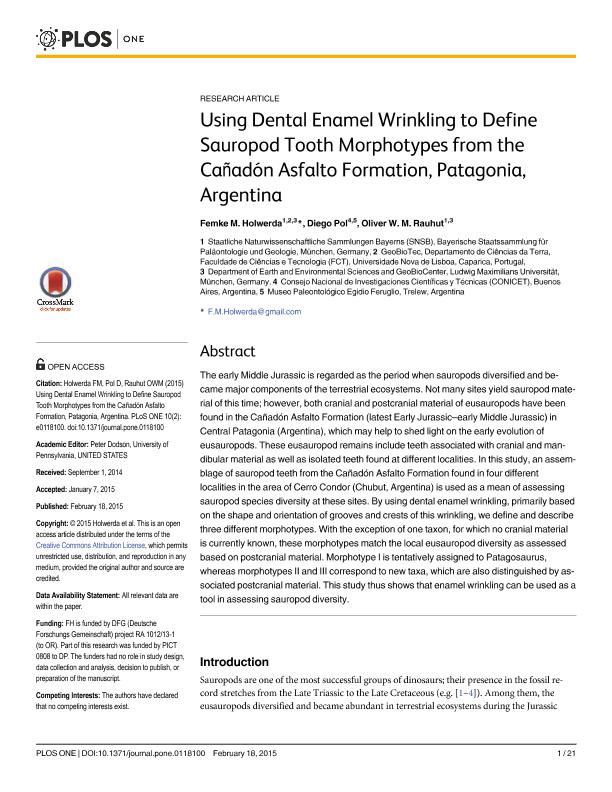Mostrar el registro sencillo del ítem
dc.contributor.author
Holwerda, Femke M.
dc.contributor.author
Pol, Diego

dc.contributor.author
Rauhut, Oliver Walter Mischa

dc.date.available
2017-07-18T21:01:53Z
dc.date.issued
2015-02
dc.identifier.citation
Holwerda, Femke M.; Pol, Diego; Rauhut, Oliver Walter Mischa; Using dental enamel wrinkling to define sauropod tooth morphotypes from the Cañadón Asfalto Formation, Patagonia, Argentina; Public Library of Science; Plos One; 10; 2; 2-2015; 1-21; e0118100
dc.identifier.issn
1932-6203
dc.identifier.uri
http://hdl.handle.net/11336/20872
dc.description.abstract
The early Middle Jurassic is regarded as the period when sauropods diversified and became major components of the terrestrial ecosystems. Not many sites yield sauropod material of this time; however, both cranial and postcranial material of eusauropods have been found in the Cañadón Asfalto Formation (latest Early Jurassic–early Middle Jurassic) in Central Patagonia (Argentina), which may help to shed light on the early evolution of eusauropods. These eusauropod remains include teeth associated with cranial and mandibular material as well as isolated teeth found at different localities. In this study, an assemblage of sauropod teeth from the Cañadón Asfalto Formation found in four different localities in the area of Cerro Condor (Chubut, Argentina) is used as a mean of assessing sauropod species diversity at these sites. By using dental enamel wrinkling, primarily based on the shape and orientation of grooves and crests of this wrinkling, we define and describe three different morphotypes. With the exception of one taxon, for which no cranial material is currently known, these morphotypes match the local eusauropod diversity as assessed based on postcranial material. Morphotype I is tentatively assigned to Patagosaurus, whereas morphotypes II and III correspond to new taxa, which are also distinguished by associated postcranial material. This study thus shows that enamel wrinkling can be used as a tool in assessing sauropod diversity.
dc.format
application/pdf
dc.language.iso
eng
dc.publisher
Public Library of Science

dc.rights
info:eu-repo/semantics/openAccess
dc.rights.uri
https://creativecommons.org/licenses/by/2.5/ar/
dc.subject
Sauropoda
dc.subject
Jurassic
dc.subject
Enamel
dc.subject
Diversity
dc.subject.classification
Paleontología

dc.subject.classification
Ciencias de la Tierra y relacionadas con el Medio Ambiente

dc.subject.classification
CIENCIAS NATURALES Y EXACTAS

dc.title
Using dental enamel wrinkling to define sauropod tooth morphotypes from the Cañadón Asfalto Formation, Patagonia, Argentina
dc.type
info:eu-repo/semantics/article
dc.type
info:ar-repo/semantics/artículo
dc.type
info:eu-repo/semantics/publishedVersion
dc.date.updated
2017-07-13T14:01:41Z
dc.journal.volume
10
dc.journal.number
2
dc.journal.pagination
1-21; e0118100
dc.journal.pais
Estados Unidos

dc.journal.ciudad
San Francisco
dc.description.fil
Fil: Holwerda, Femke M.. Universitat Genzentrum Der Ludwing-Maximilians; Alemania
dc.description.fil
Fil: Pol, Diego. Museo Paleontológico Egidio Feruglio; Argentina. Consejo Nacional de Investigaciones Científicas y Técnicas; Argentina
dc.description.fil
Fil: Rauhut, Oliver Walter Mischa. Universitat Genzentrum Der Ludwing-Maximilians; Alemania
dc.journal.title
Plos One

dc.relation.alternativeid
info:eu-repo/semantics/altIdentifier/url/http://journals.plos.org/plosone/article?id=10.1371/journal.pone.0118100
dc.relation.alternativeid
info:eu-repo/semantics/altIdentifier/doi/http://dx.doi.org/10.1371/journal.pone.0118100
dc.relation.alternativeid
info:eu-repo/semantics/altIdentifier/url/https://www.ncbi.nlm.nih.gov/pmc/articles/PMC4333578/
Archivos asociados
